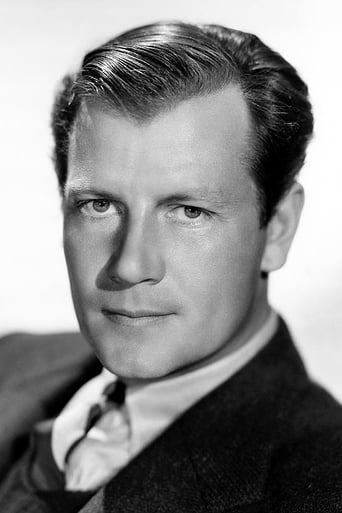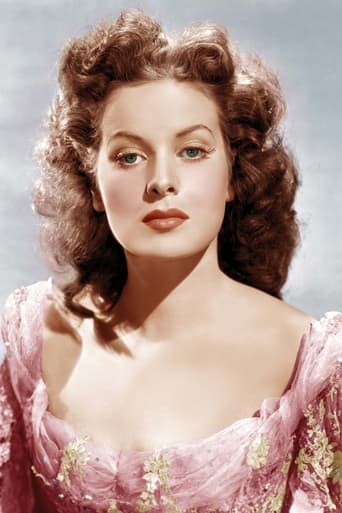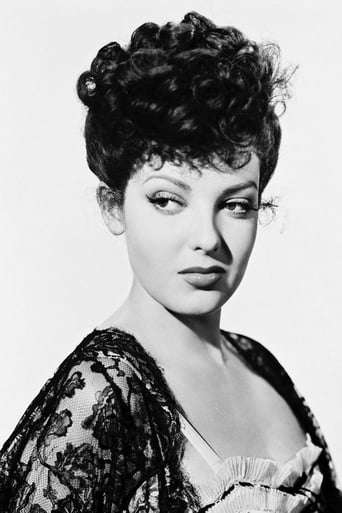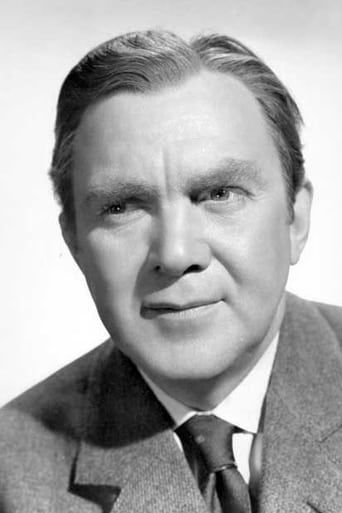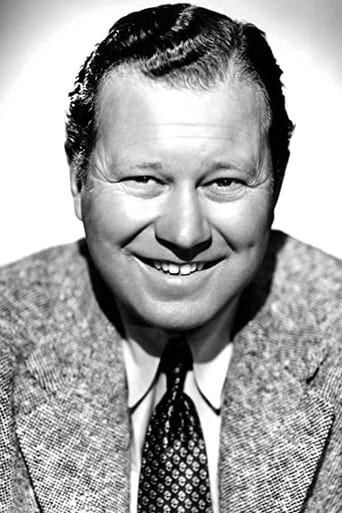Wordiezett
So much average
Claysaba
Excellent, Without a doubt!!
InformationRap
This is one of the few movies I've ever seen where the whole audience broke into spontaneous, loud applause a third of the way in.
Wuchak
"Buffalo Bill" (1944) is a a fictionalized biopic of the life of "Buffalo Bill" Cody (Joel McCrea) who worked as a scout for the US Army and later traveled East, establishing his Wild West show and becoming an international sensation.Director William Wellman and a writer worked for months on a script that told the true story of Buffalo Bill, including that he was a drunk, a charlatan and an unfaithful husband, but -- ultimately -- they said they couldn't destroy the legend, so they destroyed their screenplay and hired writers to write the myth.This explains people's criticism of this classic Western, but if you can accept that it's more myth than fact it's quite entertaining, especially considering the time it came out. Several things surprised me about this movie. For one, it clearly takes a pro-Indian stance and this was a full two decades before it become "hip" to do so. Secondly, the depiction of the Indians is good and they used real Natives as peripheral characters. Although Anthony Quinn plays Yellow Hand, he looks convincing, probably because he had Native blood.The Cheyenne and Sioux are portrayed in a noble manner as people protecting their way of life from the Europeans who don't keep their word and slaughter the buffalo en masse for no logical reason. There's a stunning scene when the Natives confront the cavalry and Yellow Hand stands up to Buffalo Bill. After the battle, Bill holds the body of an Indian woman he knew (Linda Darnell) and someone asks, "A friend of yours?" Bill sadly responds, "They were all my friends."Interestingly, a black boy is shown in one of the carnival scenes and even has a line, which is notable considering this was a full two decades before the Civil Rights movement. Some facts: The character of Yellow Hand was taken from the real-life Cheyenne chief Yellow Hair whom Cody shot, stabbed and scalped after Little Big Horn. As already noted, the movie is a whitewash and omits the fact that Cody sued his wife, Louisa Frederici (Maureen O'Hara), for divorce in 1905. They had four kids, but two died when they were young.Some criticize the way Bill stands at attention while prince Yellow Hand walks in half-naked wherein Bill lifts his hand and says "How." My Response: Didn't the Europeans (sometimes) talk with half-naked Natives when they met, which was fitting since it was the heat of the summer? So what's the problem with depicting this in the film? And wasn't "Howgh" an actual greeting with some tribes? It was. "Hau" was a greeting of the Lakota/Dakota Sioux, which is one of the two tribes depicted in the film; in fact, this greeting is still used by Sioux people today. Other tribes had similar words for greetings. As such, what's wrong with depicting this in the film, particularly since the actors pulled it off? Besides, at that time in the early 40s it hadn't become the stereotypical cliché that it later became.Bottom Line: Yes, there's some roll-your-eyes myth-making in "Buffalo Bill" (like the kid with crutches at the end), but the story maintains your attention and there's a lot of rollicking entertainment, especially the exciting Cavalry vs. Indians segments. Beyond that, McCrea and Quinn are great, the locations are spectacular, the women are beautiful and the Natives are presented in a respectable and believable way, particularly considering the picture was made in the early 40s.The film runs 89 minutes and was shot in Utah, Arizona and Montana.GRADE: B+ADDITIONAL COMMENTARY: "Buffalo Bill" was one of the first pro-Native Westerns, which came into vogue by the 60s/70s. This is a good thing because it's important to see the other side of the Indian Wars, but let's not whitewash history. The Black Hills were first inhabited by the Arikara tribe followed by the Cheyenne, Kiowa, Pawnee and Crow. These tribes were defeated by the Sioux, who migrated out of the Minnesota woods (actually chased out by their enemies, the Ojibwa and Chippewa). The Sioux then used their superior numbers to take the Black Hills from the other tribes that resided in the area.I point this out because Native Americans were guilty of the very thing we accuse European settlers/soldiers/prospectors of doing -- invading lands that weren't theirs. Furthermore, applying modern thinking is a dishonest tool when inspecting the relations between Native and settler/soldier/prospector. We always hear of the injustices committed by the US Army or settlers and get a handful of examples: Wounded Knee, Bear River and Sand Creek. Yet we never hear the other side of what caused these events nor do we hear of the atrocities of Natives committed against New Americans. For instance, we never hear of the Dakota "War" of 1862 (Santee Sioux went on the war path and murdered between 600-800 white settlers, which constituted the largest death toll inflicted upon American civilians by an enemy force until 9/11), The Ward Massacre, The Nez Perce uprising which killed dozens of settlers in Idaho and Wyoming, and the Massacre at Fort Mims. We never hear of the countless innocent settlers who were murdered by roaming bands of young "warriors": While a chief was signing a peace treaty on the tribe's behalf they were out robbing, raping and murdering. I'm just saying that it's easy to be pro-Native sitting on the comfort of your sofa, but not so much when you and your loved ones are threatened with slaughter.The Europeans wanted the Native's land and resources while the Indians wanted the technology of the Europeans. Both sides used treaties to make peace while still trying to get what they wanted when war was too expensive. Both sides made war when they felt no other option. I love Native American culture, but the whitewashing of Native atrocities and this revisionist history stuff is dishonest and unbalanced.
MartinHafer
"Buffalo Bill" is a highly romanticized picture of 'Buffalo' Bill Cody. While IMDb is correct that most of the things in this biopic are actually based on Cody's real-life exploits, most of the relationship between him and his wife was pure hooey. Sadly, there was no great love in Cody's life--or if there was, it wasn't his wife! Most of their life was spent apart by his choice--and there were other women in his life. But, this image of Bill would not have gotten past censors back in 1944, so the studio fictionalized this aspect of his life. The rest, however, is reasonably accurate--something that surprised me as I watched the film. He was a scout for the US Army in the west, he fought in the Indian wars and he did start up an incredibly successful Wild West Show.Another aspect of the film that struck me was its treatment of the American Indians--particularly the Cheyenne. It was odd, as the major roles of the 'Indians' were played by Linda Darnell and Anthony Quinn!!! This insensitivity was pretty much the way American Indians were portrayed in American films through the 1950s. HOWEVER, despite this insensitivity, the film did correctly assert that the Indian wars were forced on these people due to how they were treated by the government. And, in this way, the film was much more balanced than many westerns of the day.Overall, a somewhat inaccurate film that looked nice and featured the excellent acting, as usual, by Joel McCrea. Worth seeing--just not exactly the Gospel! And, the final line of the film might make you throw up--so when that little kid in the audience stands up, PLUG YOUR EARS!!! By the way, the film made one HUGE mistake. General Sherman NEVER said "The only good Indian is a dead Indian". This quote was actually from General Sheridan--though it's not exactly what he said. When he was asked what a good Indian was like, he said very succinctly "...a dead one".
Jay Raskin
This is one of the most underrated films of all time. It excels in every area - cinematography, acting, writing, direction, editing and production values. Yet, New York Times Critic Bosley Crowthers dismissed it as just a "colorful film" when it opened in 1944.Yet, scene after scene is brilliant, the comedy works, the romance works, the action works, and the political/philosophical points about the American West work. For example take the comic second scene of the film where Bill Cody has to wait for a letter, while the postman delivers the mail according to rank. "There are many ranker than you," he says. Delicious. There is hardly any romantic scene in a movie that matches Maureen O'Hara being taught Native American mating customs by Joel McCrea. The Battle scenes between the soldiers and Native Americans are as good as anything until "the Magnificent Seven." Politically, it intelligently denounces racism and shows that the Native Americans fought largely in self-defense. At the same time, it shows Native Americans as both fierce in battle and dignified. It makes the point that the only Indian that the Euro-American ever cared about was the Indian inscribed on their money.The movie has great writing and great lines. For example, after the army massacres a group of Native-Americans, Joel McCrea finds the dead body of Linda Darnell. She was his Native-American schoolteacher. He picks up the woman and carries her body in his arms. "A friend of yours?" quips a soldier. "They were all friends of mine," answers Bill.McCrea and O'Hara are flawless in the leads, but the acting is great down the line. Anthony Quinn and Linda Darnell as native Americans have some great scenes. Before he is about to go into battle, Quinn tells himself, the grass will still grow, the sun will still shine and the river will still flow. It eloquently shows the way Native Americans see themselves as part of nature. Darnell is wonderful as she tries to fit in with Euro-American Society only to realize that they will only always see her as an "Indian." This is the perfect Western, both exciting and intelligent. It beats out "Stagecoach," "Cimmaron," "Once Upon a Time in the West," "the Magnificent Seven" and "McCabe and Mrs. Miller" as my favorite Western only because it seems so effortless and modest.
taklasek
I enjoyed watching the film "Buffalo Bill." Unfortunately close blood relations of Buffalo Bill were still living at that time, and they should have made an effort not to make errors.Louisa Frederici met Cody in Saint Louis, and served out the end of the war there planning on making her his bride. They were married in her father's home (John Frederici) on South 8th Street in Saint Louis. They left right away for a steamboat to Kansas. Her father did not go along, and was NOT a Senator.It is a fine film, and entertaining. When Bill Cody returned to the West in 1866 he was married! There was no Linda Darnell's character. Just once I would like for Hollywood to do an exact biography without changing the facts!I am a Frederici descendant. Terry Alan Klasek Saint Louis, Missouri
